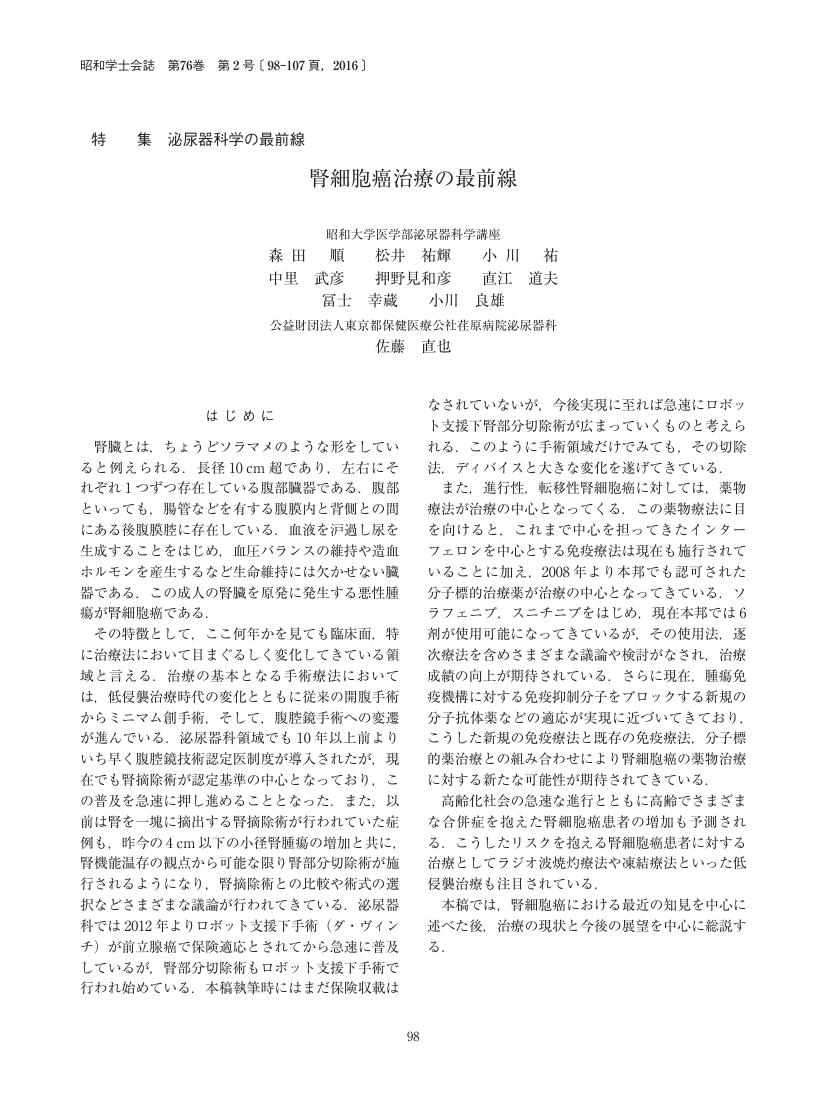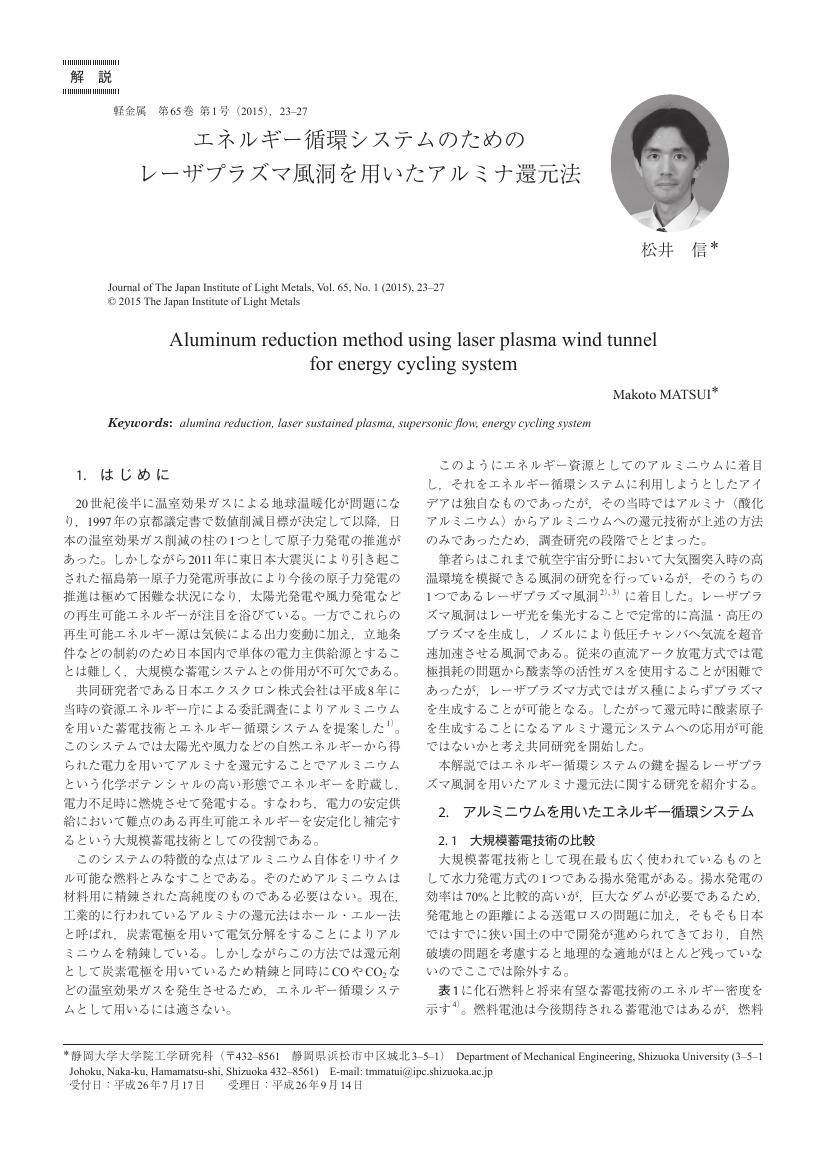2 0 0 0 OA 腎細胞癌治療の最前線
2 0 0 0 OA 進行性骨化性線維異形成症の1歳女児例
- 著者
- 八木 夏希 松井 敦 畠山 信逸 外松 学 肥沼 淳一 杉立 玲 柴 梓 清水 真理子 溝口 史剛 荒川 浩一
- 出版者
- 日本小児放射線学会
- 雑誌
- 日本小児放射線学会雑誌 (ISSN:09188487)
- 巻号頁・発行日
- vol.34, no.1, pp.49-53, 2018 (Released:2018-06-14)
- 参考文献数
- 12
Fibrodysplasia Ossificans Progressiva (FOP) is a disease that begins in infancy and is characterized by progressive ossification of skeletal muscles throughout the body. Stimuli such as injury and infection can trigger flare-ups involving subcutaneous mass formation, resulting in subsequent ossification at the site. Imaging diagnosis is often difficult in the initial phase where only a mass due to flare-up is present. In most cases, the diagnosis is made only after ossification has occurred, typically several years after the onset. Herein, we report a case of FOP diagnosed 4 months after onset. Careful imaging evaluation of the mass showed characteristics of FOP distinct from those of malignant tumors and other mass-forming lesions. Since early intervention can improve the outcome for patients with FOP, early diagnosis through careful imaging evaluation and awareness of the disease is important.
- 著者
- 梅原 久範 岡崎 和一 川 茂幸 高橋 裕樹 後藤 浩 松井 祥子 石坂 信和 赤水 尚史 佐藤 康晴 川野 充弘 厚生労働省難治性疾患等政策研究事業IgG4関連疾患の診断基準並びに診療指針の確立を目指す研究班 IgG4関連疾患包括診断基準改訂ワーキンググループ
- 出版者
- 一般社団法人 日本内科学会
- 雑誌
- 日本内科学会雑誌 (ISSN:00215384)
- 巻号頁・発行日
- vol.110, no.5, pp.962-969, 2021-05-10 (Released:2022-05-10)
- 参考文献数
- 31
- 被引用文献数
- 3
IgG4関連疾患(IgG4-related disease:IgG4-RD)は,Mikulicz病,自己免疫疾患,間質性腎炎,前立腺炎,後腹膜線維症等多彩な疾患を含む病態で,今世紀に本邦から発信された興味深い疾患である.厚生労働省のIgG4関連疾患研究班は,2011年に世界で初めての診断基準であるIgG4関連疾患包括診断基準を発表した.これにより,この新疾患は広く世界に受け入れられ,世界中から多くの報告がなされた.しかし,実臨床においては,生検組織が得られない組織があること,血清IgG4(immunoglobulin G4)値や組織中IgG4陽性細胞数のカットオフ値に対する感度・特異度等の問題が生じてきた.そのため,厚生労働省IgG4関連疾患研究班は,IgG4関連疾患包括診断基準2011を改訂した,2020年 改訂 IgG4関連疾患包括診断基準を提唱する.改訂基準は,1)臨床的・放射線学的診断,2)血清学的診断,3)病理学的診断の3項目からなる.さらに,改訂された病理学的診断基準は,従来の2項目に加え,花筵様線維化と閉塞性静脈炎を含めた3項目から構成される.
2 0 0 0 OA CTで術前診断し,腹腔鏡下手術にて治療した干し柿による食餌性イレウスの1例
- 著者
- 松井 俊樹 加藤 弘幸 湯浅 浩行
- 出版者
- 日本外科系連合学会
- 雑誌
- 日本外科系連合学会誌 (ISSN:03857883)
- 巻号頁・発行日
- vol.40, no.5, pp.896-902, 2015 (Released:2016-10-31)
- 参考文献数
- 17
- 被引用文献数
- 1 1
症例は78歳男性.腹部の手術歴はなし.入院3日前に干し柿を食べ,その後より頻回の嘔吐をきたすようになり,近医を受診した.腹部レントゲン検査にてniveau形成を認め,イレウスを疑われ,当院に紹介となった.当院でのCTにて回腸にbubbly mass and impactionを認め,それより口側の腸管が著明に拡張していたことから,食餌性イレウス疑い,同日緊急手術を行った.臍部を3cm切開し,腹腔鏡で腹腔内を観察すると,回腸末端から約50cmの部位に硬い食物の嵌頓を認め,食餌性イレウスと診断した.腸管を創外に引き出し,milkingを試みたが困難で,やむなく腸管を3cm程度切開し,嵌頓した食餌を摘出した.腸管を縫合閉鎖し,手術を終了した.嵌頓していた食餌は干し柿であった.術後経過は良好で,第7病日に退院となった.詳細な問診を行うとともに,食餌性イレウスの特徴的なCT画像所見を認識し,術前診断することができれば,低侵襲な術式を選択することも可能となると思われた.
2 0 0 0 OA 潰瘍性大腸炎の長期経過
- 著者
- 松井 敏幸 飯田 三雄 末兼 浩史 富永 雅也 八尾 恒良 櫻井 俊弘 瀬尾 充 岡田 光男 野見山 祐次 渕上 忠彦 中野 元 吉永 一彦
- 出版者
- 一般財団法人 日本消化器病学会
- 雑誌
- 日本消化器病学会雑誌 (ISSN:04466586)
- 巻号頁・発行日
- vol.90, no.2, pp.134-143, 1993 (Released:2007-12-26)
- 参考文献数
- 25
- 被引用文献数
- 6
潰瘍性大腸炎症例のうち10年以上経過例124例の長期予後を分析した. 最近数年間の臨床経過より長期予後を良好, 中等, 不良の3段階に分けると, その比率は約2:1:1であった. 初発時より経年的に活動年を有する頻度をみると, 次第に減少する傾向が観察され, 長期予後3群別にみると, 3群間に有意差がみられた. また初回治療前未治療期間の長いこと, 初発時重症度が重いこと, および高齢発症は予後不良の因子であった. 手術例は26例 (21.0%) あり, 発症10年後の累積手術率は16.5%で, 10年以後も手術率は上昇した. 悪性腫瘍併発例は3例, 異型上皮巣併発例は1例にみられた. 死亡例は6例であった. 累積生存率は期待生存率と有意差がなかった.
2 0 0 0 OA 環境ホルモンによる水質汚染の問題
- 著者
- 松井 三郎
- 出版者
- The Resources Processing Society of Japan
- 雑誌
- 資源処理技術 (ISSN:09124764)
- 巻号頁・発行日
- vol.47, no.2, pp.103-109, 2000-06-01 (Released:2009-06-05)
- 参考文献数
- 5
- 著者
- 梅枝 愛郎 北市 正則 松井 茂 色川 正貴 片貝 重之 中沢 次夫 飯塚 邦彦 三浦 進 笛木 隆三 小林 節雄
- 出版者
- 社団法人 日本呼吸器学会
- 雑誌
- 日本胸部疾患学会雑誌 (ISSN:03011542)
- 巻号頁・発行日
- vol.24, no.7, pp.804-809, 1986
「蚕 (カイコ)」体成分の吸入に起因する過敏性肺炎 (養蚕者肺症) の1例を報告した. 症例は48歳女性, 養蚕農家の主婦で咳, 痰, 労作時息切れ等が「繭かき」「ケバ取り」などの養蚕作業と関連して出現. 初診時軽いチアノーゼを認め, 胸部で捻髪音聴取. 血沈亢進, CRP (2+), 白血球増多, 低酸素血症, 胸部レ線でスリガラス様陰影を認め, 肺機能で拘束性障害と拡散能の低下がみられた. 免疫学的検査ではツベルクリン反応陰性で, 蚕体成分の一つである熟蚕尿に対する沈降抗体陽性であった. 肺組織には胞隔炎, 類上皮細胞肉芽腫, マッソン体が認められた. 入院後症状の自然改善が見られ, 血沈等が正常化し, ラ音の聴取されないことを確認して熟蚕尿による吸入誘発試験を行った. 吸入後捻髪音が出現し, 拡散能は前値に比し30%低下したため, 誘発試験陽性と判定した. 以上より本症例は蚕体成分である熟蚕尿に起因する過敏性肺炎 (養蚕者肺症) と診断した.
2 0 0 0 OA 「ご当地萌えキャラ」の印象の因子分析とご当地アピール効果との相関との分析
- 著者
- 松井 哲也
- 出版者
- 芸術科学会
- 雑誌
- 芸術科学会論文誌 (ISSN:13472267)
- 巻号頁・発行日
- vol.20, no.2, pp.120-128, 2021-06-30 (Released:2023-05-03)
- 参考文献数
- 20
地方自治体や地域密着型企業をアピールするために利用されるマンガ的なキャラクターである「ご当地萌えキャラ」は、現在では日本各地非常に多くの種類が展開されている。しかし、そのデザインメソッドについては十分に分析されておらず、特にこれらのキャラクターがその主たる目的である「商品や観光サービスの購入意欲の促進」という目的に叶ったデザインを有しているかどうかについては、ほとんど検討されていない。本研究では、「ご当地萌えキャラ」の外見デザインが受け手に与える影響の因子を明らかにするために、質問紙調査を行い、その結果に対して因子分析を実施した。先行研究ではバーチャルキャラクターの外見デザインには"reality"と"familiarity"の2因子が存在することが明らかにされているが、本研究で同様の質問紙を用いて分析を行った結果、「ご当地萌えキャラ」においても同様の2因子が確認できた。また、これらの因子得点と商品推薦効果の相関を調査した結果、"familiarity"因子と商品推薦効果との間に高い相関が見られた。さらに、キャラクターの等身によって「ご当地萌えキャラ」を2グループに分類し、グループ間で因子得点の分散分析を行った。その結果、頭身の高いキャラクターのほうが、より高い商品推薦効果を持つことが明らかになった。
2 0 0 0 OA がん患者を対象としたGLIM基準低栄養を用いたアウトカム予測
- 著者
- 松井 亮太
- 出版者
- 日本外科代謝栄養学会
- 雑誌
- 外科と代謝・栄養 (ISSN:03895564)
- 巻号頁・発行日
- vol.56, no.4, pp.118-123, 2022-08-15 (Released:2022-09-15)
- 参考文献数
- 30
2018年にGlobal leadership initiative on malnutrition (GLIM) criteriaが世界のコンセンサスを得た低栄養診断基準として発表され, 近年がん患者のアウトカムとの関連が報告されている. 系統的な検索を行うと, がん患者のアウトカム予測として12文献がヒットし, そのうち長期予後の検討が10文献と多く, 術後合併症の検討は6文献だった. 多くの文献でGLIM基準低栄養は術後合併症のリスク因子であり, 長期予後の独立した予後不良因子だった. 7文献は低栄養重症度別にmoderate低栄養とsevere低栄養に分けてアウトカムを比較しており, 低栄養が重症になるほどアウトカムが悪くなった. 一方で握力測定や歩行速度など身体機能を含めたmodified criteriaを用いた文献も多く, 身体機能評価を併用することで術後合併症と長期予後の予測精度が向上した. 現行のGLIM基準低栄養は術後合併症, 長期予後を含めたアウトカム予測に優れているが, 今後の診断基準改訂ではサルコペニア診断基準との整合性も含めて検討すべきかもしれない. GLIM基準低栄養は栄養介入すべき対象であり, 低栄養患者への栄養介入で術後合併症や長期予後を改善させられるのか, エビデンスの蓄積が期待される.
2 0 0 0 OA エネルギー循環システムのためのレーザプラズマ風洞を用いたアルミナ還元法
- 著者
- 松井 信
- 出版者
- 一般社団法人 軽金属学会
- 雑誌
- 軽金属 (ISSN:04515994)
- 巻号頁・発行日
- vol.65, no.1, pp.23-27, 2015-01-30 (Released:2015-04-30)
- 参考文献数
- 17
- 被引用文献数
- 1
- 著者
- 香川 正幸 吉田 悠鳥 鈴木 哲 栗田 明 松井 岳巳
- 出版者
- 一般社団法人 日本医療情報学会
- 雑誌
- 医療情報学 (ISSN:02898055)
- 巻号頁・発行日
- vol.30, no.2, pp.85-94, 2010 (Released:2015-02-20)
- 参考文献数
- 18
電波防護指針に準拠した小電力24 GHzマイクロ波レーダーを使用して,高齢者を対象とした非接触の呼吸・心拍見守りシステムを開発した.寝具用マットレスの下部にレーダー装置を設置し,呼吸・心拍に伴う体表面の微振動を計測するシステムであり,精度を向上するため2つのレーダー出力信号を組み合わせる特徴をもつ.最大の課題は,目的とする微弱な呼吸・心拍信号を四肢などの不規則な体動信号から分離抽出することであった.呼吸信号最大値および心拍信号最大値を事前に設定し,その最大値より大きい信号を体動ノイズと判定し振幅減少するAutomatic Gain Control方式をFFT周波数解析の前処理として導入した.また,レーダー信号の出力電力強度から体動の継続を判定し,体動が継続していない時間帯の呼吸・心拍数をより信頼性の高い情報として区別することにより,全体として体動に強い高精度計測が可能となった.本システムを実際に特別養護老人ホームで評価し,非接触見守りシステムの有用性を確認した.高齢者の介護では,在宅の場合も施設介護の場合も高齢者の状態変化の早期検出と介護者の身体的精神的負荷の軽減が求められており,本システムは高齢者安否確認システムの新しい方法として期待される.
- 著者
- 森 美佳 秋田 美恵子 梅沢 陽太郎 足利 朋子 山下 敦己 長江 千愛 山崎 哲 高山 成伸 金子 英恵 那和 雪乃 松井 宏晃 瀧 正志
- 出版者
- 学校法人 聖マリアンナ医科大学医学会
- 雑誌
- 聖マリアンナ医科大学雑誌 (ISSN:03872289)
- 巻号頁・発行日
- vol.45, no.3, pp.207-215, 2017 (Released:2017-12-04)
- 参考文献数
- 25
背景:ステロイドと血栓症の関連は未だ不明点が多い。我々は免疫性血小板減少症(ITP)におけるメチルプレドニゾロン(m-PSL)パルス療法前後での凝固因子の変化と,ヒト肝癌細胞株HepG2細胞を用いたm-PSLによる凝固因子遺伝子mRNA発現量の変化を検討し,m-PSLによる凝固亢進状態形成機序を考察した。方法:m-PSL(30 mg/kg/dose)を経静脈的に体内に3日間投与したITP症例(n=3)において,投与前と投与終了翌日にフィブリノゲン,プロトロンビン,凝固第V,VII,VIII,IX,X,XI,XII因子活性の変化を観察した。またm-PSL(100 μM)添加HepG2細胞における凝固因子遺伝子mRNAを定量RT-PCRにて測定した。結果:ITP症例ではm-PSLパルス療法後に第VIII因子活性の上昇(p=0.00064)を認めた。HepG2細胞では第XI因子遺伝子mRNAは有意に低下した(p=0.044)が,その他mRNA発現量の変化を認めた凝固因子遺伝子はなかった。考察:本研究結果はm-PSL投与後のFVIII: C増加が凝固亢進状態形成に関与する可能性を示唆する。しかしITP患者での凝固因子活性変化とHepG2細胞での凝固因子遺伝子mRNA発現量の変化は一致せず,m-PSLによる凝固亢進状態形成機序の解明には更なる検討を要する。
2 0 0 0 OA 心地よい清涼感の実現に向けた評価方法
- 著者
- 嶋田 格 松井 宏 澤田 真希 高石 雅之 藤田 郁尚
- 出版者
- 公益社団法人 日本油化学会
- 雑誌
- オレオサイエンス (ISSN:13458949)
- 巻号頁・発行日
- vol.15, no.9, pp.415-421, 2015 (Released:2018-02-01)
- 参考文献数
- 11
清涼化粧料には,清涼成分としてℓ-メントールが汎用されている。しかしながら,ℓ-メントールは,適度であれば快適な清涼感を付与する一方で,多すぎると灼熱感,ヒリヒリ感といった不快刺激を感じることが知られている。そこで,我々は,快適な清涼感を与える濃度範囲を確認するために,頚部を用いた清涼感評価方法を確立し,ℓ-メントールに対する感度が高いクールスティンガーを選定した。これにより,男女によるℓ-メントールの感受性の違いや,発汗時の清涼感の感じ方の違いを明らかにした。また,TRPチャネルに着目した評価方法を用いることで,ℓ-メントールによる不快刺激を1,8- シネオールが抑制することを発見した。
2 0 0 0 OA 青年の恋愛行動の構造
- 著者
- 松井 豊
- 出版者
- 心理学評論刊行会
- 雑誌
- 心理学評論 (ISSN:03861058)
- 巻号頁・発行日
- vol.33, no.3, pp.355-370, 1990 (Released:2019-07-24)
2 0 0 0 OA 1680年対蘭カピチュレーションの概要
- 著者
- 松井 真子
- 出版者
- 愛知学院大学人間文化研究所
- 雑誌
- 人間文化 : 愛知学院大学人間文化研究所紀要 = Transactions of the Institute for Cultural Studies, Aichi Gakuin University NINGEN BUNKA (ISSN:09108424)
- 巻号頁・発行日
- no.36, pp.104-87, 2021-09-20
2 0 0 0 機械学習によるイオン導電率予測モデルの性能向上
2 0 0 0 OA 近世期における富士山信仰とツーリズム
- 著者
- 松井 圭介 卯田 卓矢
- 出版者
- 公益社団法人 東京地学協会
- 雑誌
- 地学雑誌 (ISSN:0022135X)
- 巻号頁・発行日
- vol.124, no.6, pp.895-915, 2015-12-25 (Released:2016-01-27)
- 参考文献数
- 40
- 被引用文献数
- 2 4
This paper examines the relation between traditional pilgrimages to Mt. Fuji and related tourism in the pre-modern era. It takes into account the worship of Mt. Fuji as a sacred mountain and the activities of oshi pilgrim masters (low-ranking Shinto priests) who organized pilgrimages. Chapter II presents an overview of the worship of Mt. Fuji in its original form before modern times, and the historical development of that worship. Like other sacred mountains in Japan, Fuji was worshiped from a distance as a kannabi, a place where gods were believed to be enshrined. It was also worshiped as an area of the underworld, takai, where ancestral spirits rested. In addition, the mountain was thought itself to be a god: both a benevolent god who brings water and an angry god who brings natural disasters through volcanic eruptions. Historically, pilgrimages by ascetics to Mt. Fuji are first found in sources from the Heian era to the Kamakura era. Subsequently, Mt. Fuji gradually became one of the mountains of Shugendo, a Japanese ascetic-shamanist belief system incorporating Shinto and Buddhist concepts. Chapter III examines the establishment of devotional Fuji confraternities, called Fuji-ko, and the popularization of pilgrimages in modern times. The viewpoints of the various types of Fuji-ko, their religious beliefs, and aspects of their pilgrimages are discussed. In general, a Fuji-ko confraternity consisted of three officers—komoto (host of the ko), a sendatsu (guide), and sewanin (manager)—and members. They made pilgrimages in a three-to-ten-year cycle; the journey was usually a round trip of eight days and seven nights from Edo (the former name of Tokyo) to the mountain, arranged by oshi at Kamiyoshida, at the mountain's foot. Although Fuji was the main destination, others were often included. Some of these were sacred places related to Kakugyo (the founder of the pilgrimage to Mt. Fuji) and Jikigyo Miroku (the famous leader of Fujiko in the Edo era), and other sacred mountains such as Mt. Ooyama. Chapter IV examines the characteristics of Kamiyoshida, the village of oshi priests, which provided pilgrims with a range of services, including accommodation and assistance in climbing the mountain. Kamiyoshida was a particularly large settlement among those at the foot of Mt. Fuji, featuring large residences and rectangular zoning with special entrance roads. At its peak, the village had more than 100 houses aligned in a row. It was very prosperous in summer, when pilgrimages were most frequent. Chapter V examines characteristics of the pilgrimage destination and politics of location. The fact that citizens of Edo could view Mt. Fuji even though it was far away gave it a disarming allure and familiarity. Climbing the mountain was regarded as a great accomplishment, and in this way the pilgrimage became a journey of faith. The oshi priests, as the receiving party, created various legends of faith to draw pilgrims to their village rather than other starting points to Mt. Fuji or other shrines or temples. These legends contributed to the rise of Kamiyoshida and the oshi, and ultimately to their downfall.
2 0 0 0 OA 陶淵明と酒
- 著者
- 茂田井 円 松井 康子
- 出版者
- 公益財団法人 日本醸造協会
- 雑誌
- 日本醸造協会誌 (ISSN:09147314)
- 巻号頁・発行日
- vol.86, no.8, pp.587-590, 1991-08-15 (Released:2011-09-20)
- 参考文献数
- 9
中国六朝時代の大詩人陶淵明の酒好きは広く知られている。彼の酒に対する考え方や酒に対する愛着, 常時接していた酒について, その造り方を彼の記述と住んでいた地域の地理的条件を加味し検討した。さらに, 彼が「緑酒」と表現した, 酒の復元の第一歩として草麹の再現を試み, 草麹が再現できるまでの不安と成功したときの喜び, できた麹から醸しだされるであろう酒の香味について想像を働かせ, 陶淵明が感じたであろう味および酒に対して抱いた神秘性について記していただいた。
2 0 0 0 OA 医療機関のGoogleレビューにおける評点とクチコミ評価項目の分析:観察研究
- 著者
- 竹久 和志 本田 真也 日比 隆太郎 杉丸 毅 樋口 智也 松井 智子 井上 真智子 大磯 義一郎
- 出版者
- 一般社団法人 日本プライマリ・ケア連合学会
- 雑誌
- 日本プライマリ・ケア連合学会誌 (ISSN:21852928)
- 巻号頁・発行日
- vol.46, no.1, pp.2-11, 2023-03-20 (Released:2023-03-24)
- 参考文献数
- 30
目的:患者は医療機関選択の際にインターネット上の情報を参考にしている.本研究ではGoogleレビュー上の医療機関に対する評価内容を分析した.方法:静岡県の医療機関のGoogleレビューの評点とクチコミを用いた.クチコミはあらかじめ設定した12の評価項目でコード化した上で,ポジティブ,ネガティブ,分類不能,記述なしに分類し,修正ポアソン回帰分析で評点との関連を分析した.結果:対象の医療機関は2,044施設,クチコミ数は13,769件であった.「医師の応対」に触れたクチコミが最も多く(5,035件),ポジティブなクチコミは高評価(偏回帰係数:0.76,95%信頼区間:0.70~0.82)と,ネガティブなクチコミは低評価(-4.65,-5.24~-4.06)と有意な関連があった.結論:Googleレビューにおいては,医師の応対に関するクチコミが評点に影響を与えていた.
2 0 0 0 白血病・悪性リンパ腫における肺合併症
- 著者
- 森下 剛久 清水 鈴昭 井村 洋 岡本 昌隆 小野 芳孝 斉藤 稔 中村 康一 松井 俊和 重村 はるひ 井野 晶夫 江崎 幸治 平野 正美
- 出版者
- 一般社団法人 日本血液学会
- 雑誌
- 臨床血液 (ISSN:04851439)
- 巻号頁・発行日
- vol.25, no.5, pp.627-639, 1984 (Released:2009-01-26)
- 参考文献数
- 22
- 被引用文献数
- 2
Pulmonary complications were studied in 213 patients with leukemia and lymphoma. The incidence of pulmonary lesions was 38.5% and diffuse changes were encountered twice more frequently than localized ones. Etiological diagnosis during life was difficult. In 38 out of 62 cases with diffuse lesions, their etiology was not determined. In 9 out of 28 cases with localized lesions their etiology was not clear. In some of these cases autopsy clarified their etiology.Among localized cases, infection, mainly of bacterial origin and infiltration of underlying diseases were two main etiologies. On the other hand, diffuse lung lesions were of various etiology; 29 infections (bacteria 8, fungus 9, virus 8, p.carinii 2), 11 tumor infiltrations, 11 interstitial pneumonia, 3 vascular origins. In these cases with diffuse lesions of different etiology, clinical findings such as fever, cough, dyspnea, low PO2, high LDH, increased CRP, and hypoalbuminemia were observed, but not helpful in differentiating the etiology. Eight out of 11 cases of interstitial pneumoonia occurred during or after tapering of glucocorticoid.The mortality rate was as high as 54.4% of all lung diseases. Retrospective studies on the chest X-ray pictures showed that diffuse ill-defined opacities or multilocated consolidations were associated with poor prognosis.The diagnostic value of transbronchoscopic lung biopsy and therapeutic implications of empirical glucocorticoid administration for etiologically undiagnosed lung lesions were also discussed.



